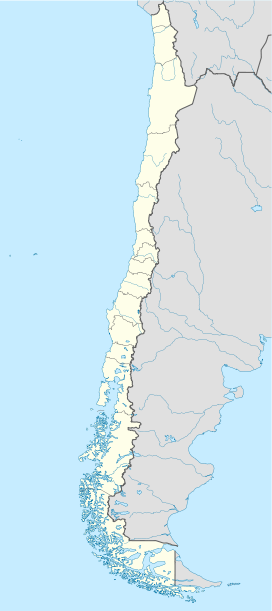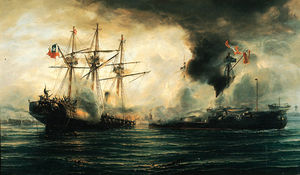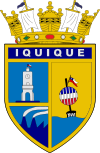Iquique
| Iquique | |||
|---|---|---|---|
| — Commune — | |||
|
|
|||
|
|||
 |
|||
 Iquique
|
|||
| Coordinates: | |||
| Country | Chile | ||
| Region | Tarapacá | ||
| Province | Tamarugal | ||
| Founded | 16th Century | ||
| Government | |||
| - Type | Municipal council | ||
| - Mayor | |||
| Area[1] | |||
| - Commune | 2,835.3 km2 (1,094.7 sq mi) | ||
| Population (2002)[1] | |||
| - Commune | 216,419 | ||
| - Density | 76.3/km2 (197.7/sq mi) | ||
| - Urban | 214,586 | ||
| - Rural | 1,833 | ||
| Sex[1] | |||
| - Male | 108897 | ||
| - Female | 107522 | ||
| Time zone | CLT (UTC-4) | ||
| - Summer (DST) | CLT (UTC-3) | ||
Iquique (Spanish pronunciation: [iˈkike]) is a city and commune in northern Chile, capital of Tarapacá Region, on the Pacific coast, west of the Atacama Desert and the Pampa del Tamarugal. It had a population of 216,419 as of the 2002 census.[2] It is also the main commune of the Greater Iquique.
Iquique has one of the largest duty-free commercial port centers (or Zona Franca) of South America and has been traditionally called Zofri. There are around 2.4 square kilometres (0.93 sq mi) of warehouses, banking branches, and restaurants.
Copper mining, mainly in Quebrada Blanca, Cerro Colorado, and Doña Inés de Collahuasí, is also an important industry in Iquique.
Contents |
History
Although the city was founded in the sixteenth century, there is evidence of habitation in the area by the Chango people as early as 7000 BC. During colonial times, Iquique was part of the Viceroyalty of Peru as much of South America was at the time, and remained part of Peruvian territory until the end of the 19th century. Iquique's early development was due in large part to the discovery of mineral riches, particularly the presence of large deposits of sodium nitrate in the Atacama Desert (then part of Peruvian territory).

Territorial disputes between Bolivia and Chile triggered the War of the Pacific in 1879. The outcome of the war gave Chile this portion of the Peruvian territory. Over the years there was substantial emigration from other parts of Chile to this area which was called the Norte Grande. In subsequent years the further exportation of Chilean saltpeter (mainly to European countries) significantly helped in the development of the city, attracting foreigners and rapidly expanding housing projects.
In December 1907, the city was marred by the Santa María de Iquique Massacre when the Chilean Army, under the command of Gen. Roberto Silva-Renard, opened fire on thousands of saltpeter miners, and their wives and children, who assembled inside the Santa María School. The workers had marched into town to protest their working conditions and wages. Somewhere between 500 and 2,000 people were killed. The folk group Quilapayún recorded an album in remembrance of the event (Cantata Santa María de Iquique) in 1970. In December 2007 a series of cultural and ceremonial activities have been planned, culminating in the week between 14 to 21 December, to commemorate the centenary year of the massacre. Prior to becoming Chilean territory, Iquique was home to some of the greatest Peruvian heroes, namely Alfonso Ugarte (who was elected Mayor in 1876), Ramon Zavala, a rich saltpeter entrepreneur; Guillermo Billinghurst, later President of Peru (who after being overthrown in 1914 came to Iquique - then already under Chilean rule - to live out his last years), and Ramon Castilla, three times president of Peru, who was born in San Lorenzo de Tarapacá and died in the Desert of Tiviliche, Tarapacá, who lived in Iquique during his mandate as Governor of Tarapacá in 1825.
Trivia
In July 1835, Charles Darwin, during his voyage on the Beagle, traveled to Iquique and described it as a town "very much in want of everyday necessities, such as water and firewood". These necessities had to be brought in from considerable distances. Darwin also visited the saltpeter works.
In 1868 and again in 1877, the former Peruvian city was devastated by earthquakes. On 13 June 2005 there was yet another earthquake, with a magnitude of 7.9 on the Richter Scale.
The Battle of Iquique was fought in the harbor of Iquique on 21 May 1879, now commemorated as Navy Day, an annual public holiday in Chile.
The most recent accident involving a spacecraft RTG was the failure of the Russian Mars 96 probe launch on 16 November 1996. The two RTGs onboard carried in total 200 g of plutonium and are assumed to have survived reentry (as they were designed to do). They are thought to now lie somewhere in a northeast-southwest running oval 320 km long by 80 km wide which is centred 32 km east of Iquique, Chile.
The 2009 South American Under 17 Football Championship was held at the Estadio Tierra de Campeones in Iquique with Brazil emerging victorious.
Gallery
|
Baquedano Boulevard |
 Downtown Iquique |
 Municipal Theater of Iquique |
 Iquique Municipal Theatre at night |
References
- ↑ 1.0 1.1 1.2 (Spanish) Instituto Nacional de Estadísticas
- ↑ Instituto Nacional de Estadísticas, Censos 2002, accessed 10 July 2007
External links
- (Spanish) Waykike magazine
- (Spanish) Iquique's CityHall
- (English) Digital Newspaper Iquique On Line
- (Spanish) Somos Iquique Blog
- Iquique photos on Flickr
- (Spanish) Zona Franca de Iquique
- (Spanish) Primer Portal de la Region Tarapaca (Iquique y el Tamarugal)
- (Spanish) Santa Maria de Iquique Massacre Centenary
|
||||||||||
|
|||||


